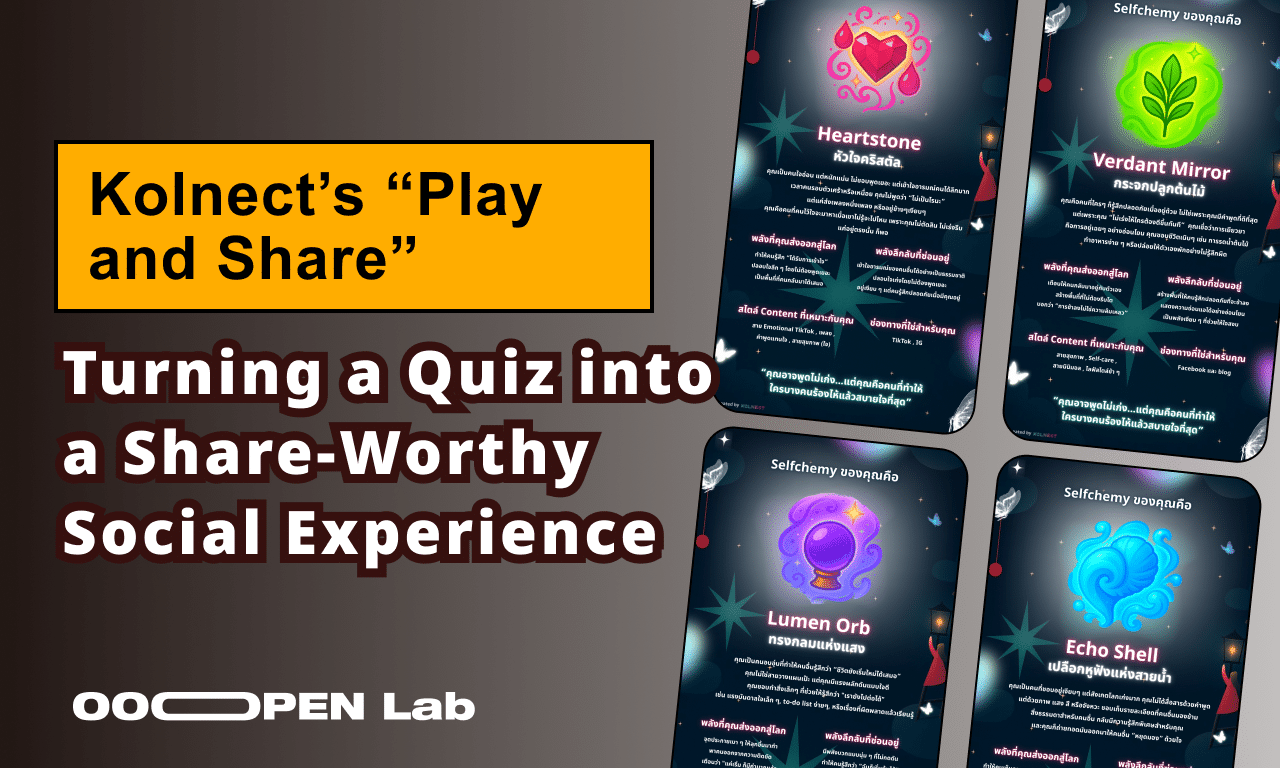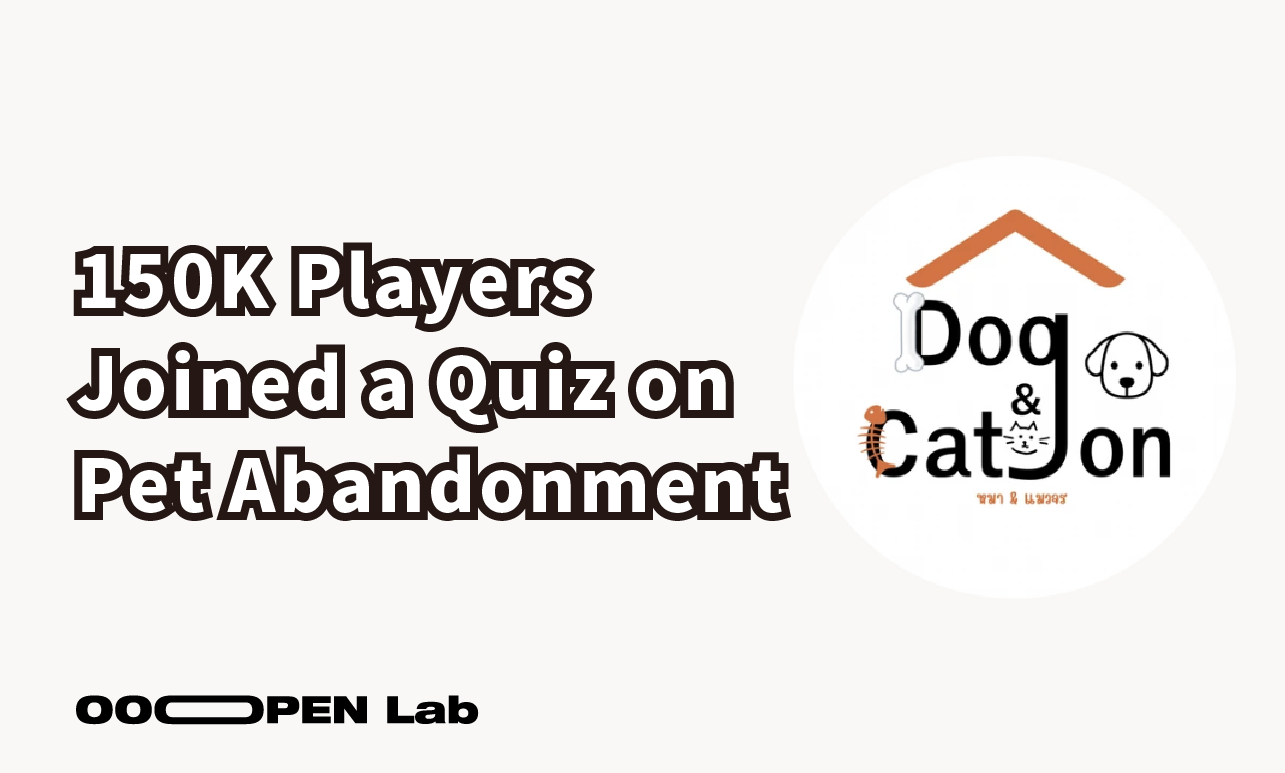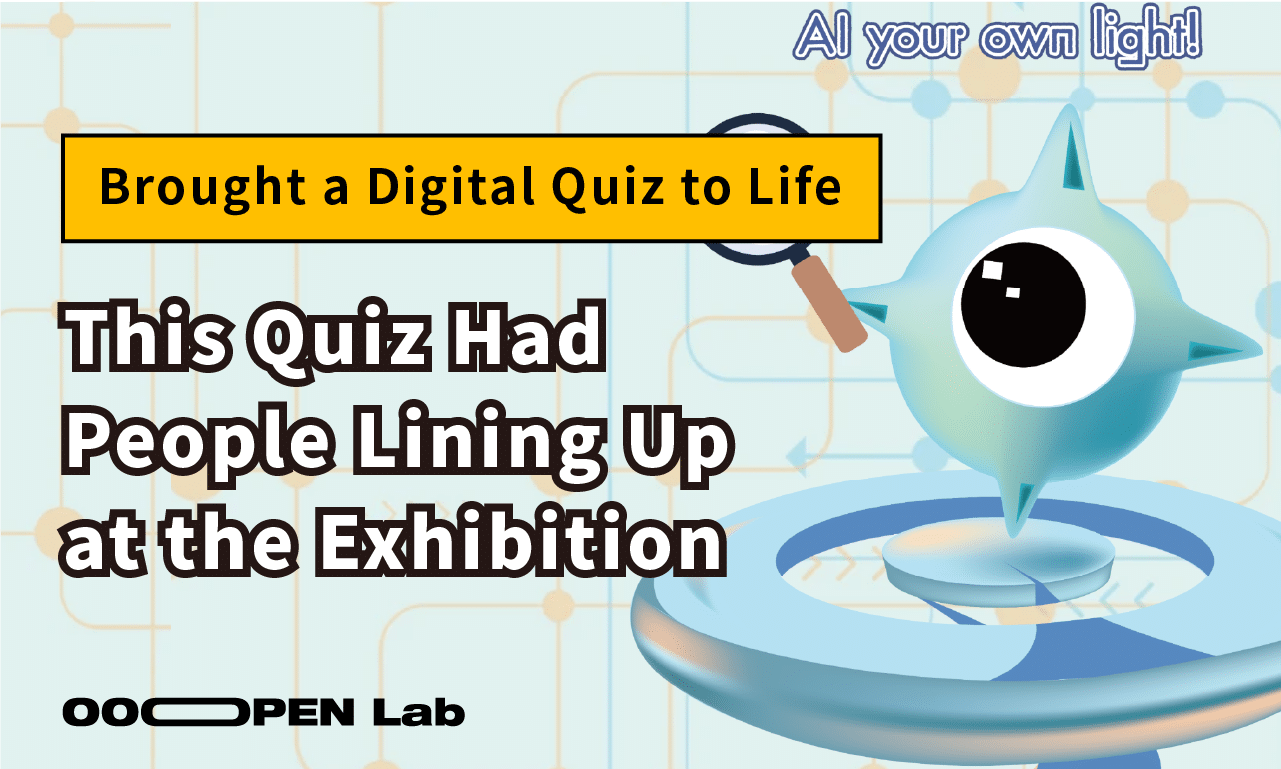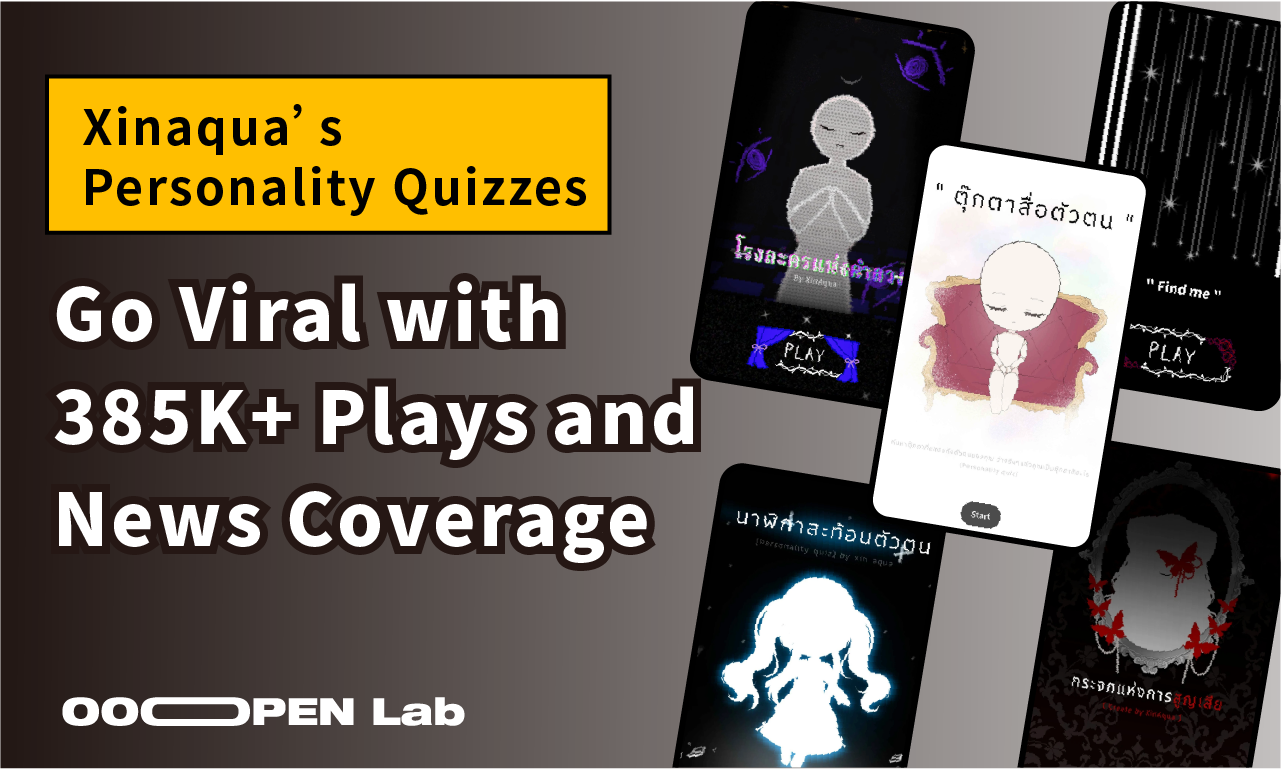Kolnect developed the project “The Laboratory of Selfhood” by transforming the psychological quiz into an interactive storytelling experience.
Players gradually discover more about themselves through the world of Selfchemy, using OOOPEN Lab’s tools that help maintain a continuous and structured design workflow. The project received an overwhelming response: users truly finished it, genuinely shared it,and organically reached new audiences. This article explores the core ideas, creative process, and key lessons the team learned from developing this project.
Created by: Malini Phetkon — Pen name: Malimuay
Design & Development by: Kolnect (a creative unit under Ideaslabs Co., Ltd., Thailand)
The Background and Inspiration Behind the Project
Could you share with us what primary outcomes you aimed for in the project “The Laboratory of Selfhood”?
The initial intention was to help players get to know Kolnect, so they could understand the platform’s core philosophy that “everyone can be a creator” once they recognize their own strengths and personal style. This project was meant to be a creative experiment and a communication tool that expresses Kolnect’s identity in a fun, accessible, and meaningful way for real players. And we wanted anyone to be able to play it—no need to already be a creator.
At the beginning, which group of players did you aim to resonate or connect with this project the most?
The group we most wanted to connect with were people in the phase of “discovering themselves”—whether creators, students, or anyone wanting to understand themselves better. I chose the ideas of a “laboratory” and “alchemy” because they represent an inner experimentation process where fragments of experiences, emotions, and thoughts combine into a “new substance” that uniquely reflects each person’s identity.
What inspired the use of the terms “laboratory” and “Selfchemy” in the project name? And why did you ultimately choose OOOPEN Lab as the platform to build this project?
The project name “The Laboratory of Selfhood” comes from the concept of “Selfchemy,” which blends the words Self and Alchemy—meaning the process of “distilling one’s identity into a creative force.” The inspiration came from Ideaslabs’ idea of “the laboratory of ideas,” which I wanted to extend into “the laboratory of the self,” where anyone can craft their own unique formula.
We chose OOOPEN Lab because the platform truly enables interactive storytelling and aligns best with the project’s experimental direction.
Both in terms of player experience and narrative design, OOOPEN Lab helped “The Laboratory of Selfhood” feel alive and more accessible to everyone.
The Process of Creating the Quiz
Why did you choose to use the “Personality Quiz Module” for this project? Had you created similar quiz-based projects before?
I chose the Personality Quiz module because it aligns perfectly with the concept of Selfchemy,
where players “discover themselves through experimentation.”
The quiz transforms each of the player’s answers into a part of the alchemical process—gradually distilling ordinary questions into a “power” or “Selfchemy object” that represents their individual identity.
It’s not just a personality game, but a simulation of an “inner laboratory,” allowing players to truly take part in the narrative.
Before this, I had created storytelling-style quiz projects, but they were mostly early prototypes—simple experiments for friends and seniors to try. “The Laboratory of Selfhood” is the first time I intentionally designed a quiz as a fully narrative-based system, where each question flows like a journey through the world of Selfchemy.
Among all the features in OOOPEN Lab, which one did you find the easiest to use or the most helpful?
The most useful feature is the Question–Result System.
It allows you to build a seamless narrative flow freely, and makes it very easy to adjust visuals, result pages, and written content so everything stays within the same theme.
This feature made it possible to organize a complex project like Selfchemy in a clear, structured way, letting me see the entire storyline without needing to write any code.
During the creative process, did you use any AI tools? If so, at which stage did AI help you the most?
I started with a clear concept and vision—the “laboratory” theme, the atmosphere, and the emotions I wanted players to experience. After that, I used AI mainly to help reorganize the content and refine the pacing of the questions, making the flow smoother and more creative.
When designing the questions and character outcomes, how did you connect elements such as “doors,” “magic potions,” and the “memory test” to guide players deeper into the world of Selfchemy?
I designed each element in the game to function like a “step in the experiment of self-discovery.” For example, the Door symbolizes the moment a person decides to begin exploring themselves, while the Magic Potion represents the power or qualities shaped through each person’s unique experiences.
Behind the questions and outcomes, I used MBTI as a reference framework to anticipate players’ thought patterns and behavioral tendencies—not to categorize them, but to make the experience more “personalized.”
For instance, the pathway of someone with Introvert tendencies is filled with observation and reflection, whereas Extrovert players experience more action and momentum.
All of these elements were designed to flow continuously—like moving through an actual laboratory. From opening the door, to entering the experiment, and finally distilling the “Selfchemy Object,” which reflects each person’s unique power and personality.
Results and Player Feedback
Do you feel that this project met—or even exceeded—your original expectations? And what indicators did you use to evaluate the results?
This project definitely met—and exceeded—my expectations. At first, it was meant to be just a creative quiz to promote Kolnect’s philosophy, but the results turned out far beyond what I had anticipated: the number of players who completed the quiz, the share rate, and the feedback from people who discovered it without knowing us beforehand.
But what made me happiest was receiving messages from people who already enjoy personality quizzes saying, “This quiz feels different from others I’ve played. I could visualize the scenes while going through it.”
At that moment, I felt that all the intention poured into the project truly reached the players. The main indicators I used were completion rate, number of shares, and direct comments or feedback messages from players.
Were there any data points or results that surprised you?
The most surprising result was the number of players who not only completed the quiz but shared it—far higher than expected. Especially during the first week after launch, the number of people who tried it was several times more than our initial target.
Most players also spent a long time on each narrative section, which shows that they weren’t just clicking through—they were truly “immersed in the experience.” Another delightful insight was that many people came back to replay it just to see how different answers would affect their results. This shows that the project wasn’t treated as just another quiz, but as an experimental space that people wanted to “return to.”
Were there any particularly memorable comments or reactions from players or the community?
There were many memorable feedback messages, but the one that touched me most was when someone—who had never heard of the project—tried it by chance, then shared their results on social media and tagged friends to try it too.
It became a naturally self-spreading chain, as if the project grew organically through real players without heavy promotion. That moment made me feel that the concept of “The Laboratory of Selfhood” was truly connecting with people as intended.
Promotion Strategy and Organic Growth
Which channels did you primarily use to promote this project?
I mainly used Kolnect’s Instagram and Facebook channels for promotion, since they already supported our target audience and allowed the project’s story to be conveyed effectively through visuals and short narratives. I also shared the project through my personal channels to reach new players who were interested in self-discovery content and personality-based games.
Did you design any specific strategies or special content for the promotion?
Yes, I created a special set of content using a “play and share immediately” approach. I designed all six Selfchemy result images in IG Story format, so players could save and share them instantly, including a section for tagging friends. This allowed the content to spread organically through real players without relying on advertisements—turning players themselves into part of the promotion.
During the promotion, which methods or types of content worked best?
The most effective content was the Selfchemy IG Story Templates. Players could share them instantly without editing, which naturally encouraged sharing. Many tagged friends to compare results, turning it into a small organic social activity.
Some users even saved their results in their Story highlights as a “symbol of identity” they wanted to remember. This helped the project remain visible on players’ feeds even after they had completed the quiz.
Did you use hashtags, collaborate with KOLs, or run any interactive activities as part of the campaign? If yes, can you give an example?
There was no direct collaboration with KOLs—instead, we relied on everyday players to spread the project organically.
I encouraged players to share their results with the hashtags #Selfchemy and #ห้องทดลองตัวตน, making it easy to search and follow the content. As more people shared, others naturally tagged friends, creating a chain of interactive social engagement that kept the project growing without any paid promotion.
Did you see the “audience circle” expanding into new groups (e.g., different age groups or communities outside your original target)?
Yes. After the project was launched for a while, we started seeing engagement from audiences beyond Kolnect’s original target group. Although the project was initially intended for creators and content-makers, many new players—including students, university groups, designers, and people interested in self-growth—started joining. What’s interesting is that many of them didn’t know Kolnect beforehand; they joined simply because they were drawn to the concept of “The Laboratory of Selfhood.” This project unintentionally became a bridge between the brand and a much wider audience, growing organically through player-driven sharing.
Future Directions and Creator Advice
Do you have plans to try new themes or modules in the future?
Yes. Since OOOPEN Lab continuously releases new modules, I’ve started having new ideas I’d like to explore—such as creating “mini laboratories” for self-exploration in areas like memory, relationships, or inspiration.
I’m also interested in trying new modules that spark fresh ideas for future creations. Not just extensions of this project, but entirely new concepts that let players experience new forms of fun, experimentation, and self-reflection.
If you were to give advice to other creators, what techniques or process steps would you recommend?
I recommend starting with defining the “emotion you want players to feel.”
Once the emotional goal is clear, designing the questions and storyline becomes much easier.
What worked well for me was planning the narrative as a continuous journey,
then adding questions that matched the emotional tone of each moment.
Also—don’t be afraid to experiment with OOOPEN Lab’s modules.
You can always adjust and refine.
Try multiple versions and you’ll quickly see what resonates most with players.
Now register as a Creator and start building with the free trial right away!
Simply click “Login/Register” at the top right to become a Creator. With the free plan, you can create, edit, and publish unlimited projects with no time limit!
The free plan currently offers unlimited trial use with some feature restrictions. You can view details in the backend under “Purchase Plan > Click to Expand Full Feature Comparison Table.” Before officially publishing, simply purchase a plan online to instantly activate your account and unlock publishing permissions within 1 minute!




